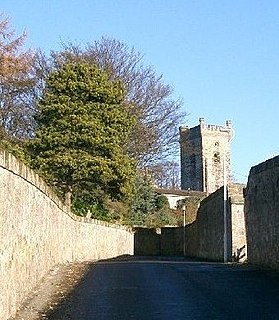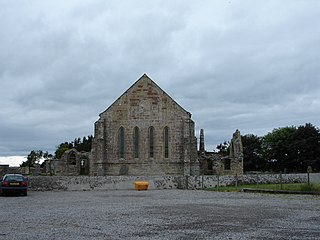
Holyrood Abbey is a ruined abbey of the Canons Regular in Edinburgh, Scotland. The abbey was founded in 1128 by David I of Scotland. During the 15th century, the abbey guesthouse was developed into a royal residence, and after the Scottish Reformation the Palace of Holyroodhouse was expanded further. The abbey church was used as a parish church until the 17th century, and has been ruined since the 18th century. The remaining walls of the abbey lie adjacent to the palace, at the eastern end of Edinburgh's Royal Mile. The site of the abbey is protected as a scheduled monument.
The Abbot of Paisley was the head of the Cluniac monastic community of Paisley Abbey and its property. The monastery was founded as a priory at Renfrew in 1163, but moved to Paisley in 1169. It became an abbey in 1219. The founder was Walter fitz Alan, Seneschal (Steward) of Scotland. The line of abbots ended when it was turned into a secular lordship for Lord Claud Hamilton in 1587/1592. The following is a list of abbots and commendators:
The Abbot of Kelso was the head of the Tironensian monastic community at Kelso Abbey in the Scottish Borders. The Abbey was originally founded at Selkirk in 1113 by David, Prince of the Cumbrians, and thus the first three Abbots were Abbot of Selkirk. It was moved to Kelso by David and John, Bishop of Glasgow in 1127. The abbot was the first in Scotland to be granted the mitre in 1165. In the 16th century the monastery increasingly came under secular control, and finally in 1607 it was granted as a secular lordship (Holydean) to its last commendator, Robert Ker of Cesford, later Earl of Roxburghe. The following is a list of abbots and commendators:

The Abbot and then Commendator of Culross was the head of the monastic community of Culross Abbey, Fife, Scotland. The abbey was founded in 1218 on the patronage of Maol Choluim I, Earl of Fife by Cistercian monks from Kinloss Abbey, Moray. Control of the abbey was secularized in the 16th century and after the accession of James Stewart, the abbey was held by commendators. The number of monks under the abbot had also declined by the 16th century, there being only 15 monks by 1557.

The Prior, then Abbot and then Commendator of Dunfermline was the head of the Benedictine monastic community of Dunfermline Abbey, Fife, Scotland. The abbey itself was founded in 1128 by King David I of Scotland, but was of earlier origin. King Máel Coluim mac Donnchada had founded a church there with the help of Benedictines from Canterbury. Monks had been sent there in the reign of Étgar mac Maíl Choluim and Anselm had sent a letter requesting that Étgar's brother and successor King Alaxandair mac Maíl Coluim protect these monks. By 1120, when Alaxandair sent a delegation to Canterbury to secure Eadmer for the bishopric of St Andrews, there is a Prior of the Dunfermline monks by the name of Peter leading the delegation. Control of the abbey was secularized in the 16th century and after the accession of James Stewart in 1500, the abbey was held by commendators. In the second half of the 16th century, the abbey's lands were being carved up into lordships and it was finally annexed to the crown in July, 1593.
The Prior of St Andrews was the head of the property and community of Augustinian canons of St Andrews Cathedral Priory, St Andrews, Fife, Scotland. It was established by King David I in 1140 with canons from Nostell Priory, West Yorkshire. It is possible that, initially at least, the prior of St Andrews was subordinate to the bishop as abbot, but by the 13th century the canons of St Andrews were given freedom by the bishop to elect their prior. By the end of the 13th century, the abbacy of the native canons was no longer there to challenge the position of the priory, and the native canons themselves had been formed into a collegiate church.
The Prior of Whithorn was the head of the monastic community at Whithorn Priory, attached to the bishopric of Galloway at Whithorn. It was originally an Augustinian establishment, but became Premonstratensian by the time of the second or third known prior. As most of the priors of Whithorn appear to be native Galwegian Gaels, it would appear that most priors before the 16th century at least were drawn from region, something unusual in medieval Scotland. The following is a list of abbots and commendators.
The Abbot of Balmerino was the head of the Cistercian monastic community and lands of Balmerino Abbey, Fife, founded in 1227 x 1229 by monks from Melrose Abbey with the patronage of Ermengarde de Beaumont and King Alexander II of Scotland. The following are a list of abbots and commendators.
The Abbot of Kinloss was the head of the property and Cistercian monastic community of Kinloss Abbey, Moray, founded by King David I of Scotland around 1151 by monks from Melrose Abbey. The abbey was transformed into a temporal lordship for Edward Bruce, the last commendator, who became Lord Kinloss. The following is a list of abbots and commendators:
The Abbot of Dundrennan was the head of the Cistercian monastic community of Dundrennan Abbey, Galloway. It was founded by Fergus of Galloway in 1142. Dundrennan was a large and powerful monastery in the context of the south-west. It became secularised and protestantised in the 16th century. In 1606 it was finally turned into a secular lordship in for John Murray of Lochmaben, afterwards earl of Annandale.
The Abbot of Glenluce was the head of the monastic community of Glenluce Abbey, Galloway. The monastery was founded in 1192 by monks from Dundrennan Abbey with the patronage of Lochlann (Roland), Lord of Galloway. In the 16th century the monastery increasingly came under the control of secular warlords. In 1560 the monastery was occupied by James Gordon of Lochinvar, and the monks were expelled. However, soon after, Thomas Hay, a follower of the earl of Cassillis, was installed in the monastery as commendator and the monks were allowed to return. However, monastic life seems to have disappeared by the end of the century. In 1602 parliament granted the lands of the monastery to Lawrence Gordon as a secular lordship. The abbey was finally given to the bishop of Galloway in 1619. The following is a list of abbots and abbot-commendators:

The Abbot of Fearn was the head of the Premonstratensian monastic community of Fearn Abbey, Easter Ross, Scotland. The Abbey was founded by canons from Whithorn Priory in Galloway, with the patronage of Fearchar mac an t-Sagairt, mormaer/earl of Ross. The foundation took place in the 1220s, according to the two distinct foundation dates given in the sources, either in 1221 or in 1227. Until about 1238, the Abbey was located at Fearn, near Edderton, but it was moved to the Tarbat parish in that year and known thereafter as "nova Furnia". Despite the fact that the head of Whithorn Priory was a prior and Fearn an abbot, Fearn seems to have remained subordinate to Whithorn until at least the end of the 14th century, and even in 1440 Abbot Fionnlagh II was confirmed by the prior of Whithorn.The reason for this is that Whithorn was a cathedral priory; the nominal head of its community was the bishop, but its actual head was the prior, as was the common use in England at places like Durham and Carlisle, but this was not usual in Scotland. In these circumstances the cathedral prior had the same rights as an ordinary abbot.
The Abbot of Tongland was the head of the Premonstratensian monastic community of Tongland Abbey in the historical county of Kirkcudbrightshire in Dumfries and Galloway. The following is a list of abbots and commendators:

Tungland or Tongland Abbey was a Premonstratensian monastic community located in Tongland in the historical county of Kirkcudbrightshire in Dumfries and Galloway, Scotland. It was probably founded circa 1218 by Alan, Lord of Galloway, although the church of Tongland had previously been granted to Holyrood Abbey by his grandfather Uchtred in the early 1160s. Few of its early abbots are known and its history is more generally covered by a cloud of obscurity.
The Abbot of Cambuskenneth or Abbot of Stirling was the head of the Arrouaisian (Augustinian) monastic community of Cambuskenneth Abbey, near Stirling. The long history of the abbey came to a formal end when the abbey was turned into a secular lordship for the last commendator, Alexander Erskine.
The Prior of St Mary's Isle was the head of the Augustinian monastic community of St Mary's Isle Priory, in Kirkcudbrightshire, Galloway. The following is a list of priors and commendators:
The Prior of Coldingham was the head of the Benedictine monastic community of Coldingham Priory in Berwickshire. Coldingham Priory was founded in the reign of David I of Scotland, although his older brother and predecessor King Edgar of Scotland had granted the land of Coldingham to the Church of Durham in 1098, and a church was constructed by him and presented in 1100 AD. The first prior is on record by the year 1147, although an earlier foundation is almost certain. The monastic cell was a dependent of Durham until the 1370s, and in 1378 King Robert II of Scotland expelled the Durham monks; for the following century the cell had two priors, one chosen by Durham and one chosen by the Scots. It became a dependent of Dunfermline Abbey. It was subject to increasingly secular control from the late 15th century into the 16th century. The following is a list of priors and commendators:






